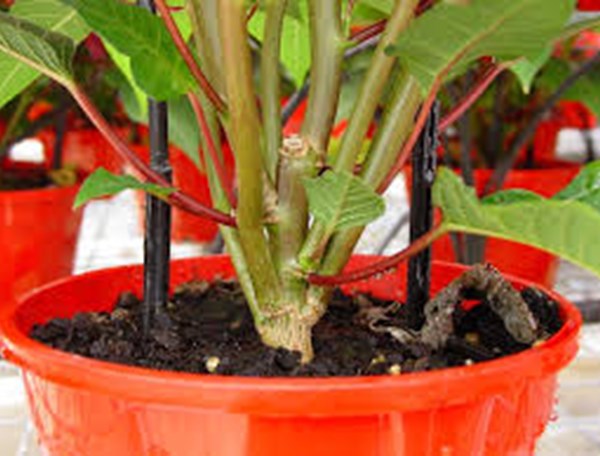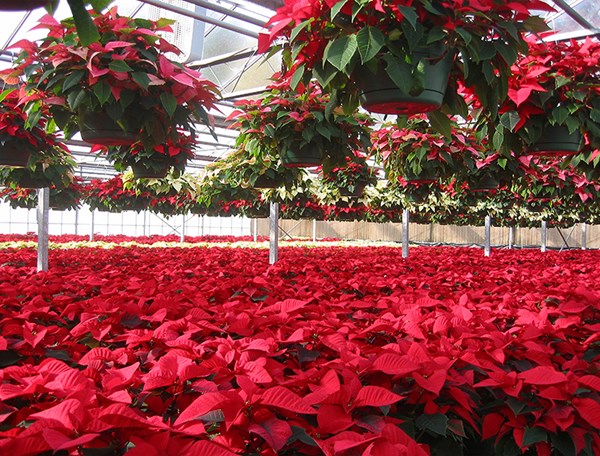Training Center
Cool Growing Poinsettias
Thursday, September 7, 2023 | Ed Bloodnick
In a competitive market, growers are always looking for ways to save money while still producing a quality crop. When it comes to growing poinsettias, one expense that increases towards the end of the crop cycle is heating costs.
Due to this, some growers have adopted “growing cool” at the end of the crop cycle. What this means is that growing temperature is reduced when bracts begin to color, typically from mid-October to early November. Since outdoor temperature is coldest during this time, there can be savings on heating costs. But be cautious, this growth method has risks.
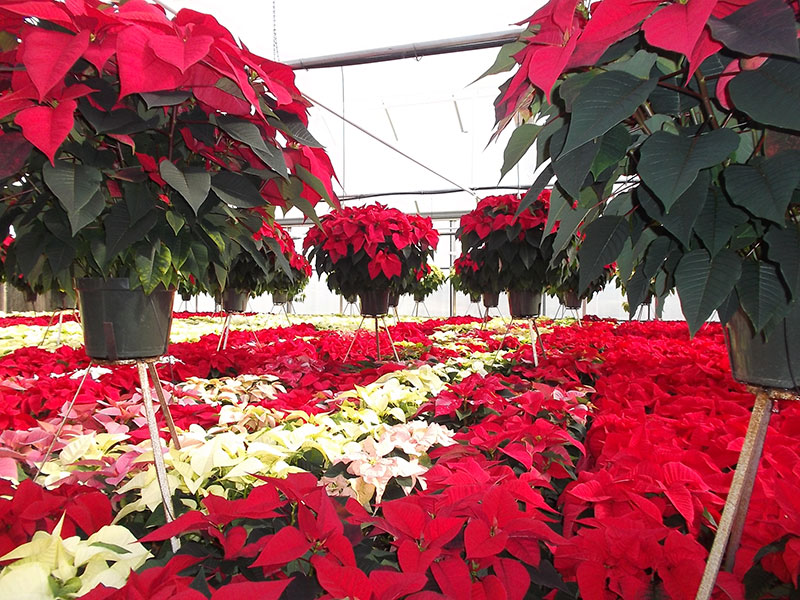
Quality poinsettia crop. Source: Premier Tech
Related Articles:
Preparing the Plant
Top Growth
Before poinsettias are grown cool, it best to build the plant architecture. Poinsettia top growth should be close to final height and size, prior to growing cool. Cooler temperatures will hold back stem elongation, so if the poinsettias are shorter than expected prior to growing cool, they will not finish at the correct height. If this is a concern, start poinsettias 1-2 weeks earlier so they have more time to develop proper height and size.
Root Growth
Poinsettias need a well-developed root system before growing cold. During the shorter, cooler days from late October until Christmas, humidity levels in the greenhouse are often high and poinsettias use less water from the growing medium, causing it to dry out more slowly. Growing cooler further exacerbates poor dry-down, therefore if poinsettias have a poor root system, it becomes easier to overwater the growing medium, which increases root stress and susceptibility to Pythium root rot.
Check roots once or twice per week during this time for root disease. To help mitigate these issues, it is best to use PRO-MIX HP BIOFUNGICIDE* + MYCORRHIZAE as it has better drainage and lower water retention capacities. It also contains BIOFUNGICIDE*, which contributes to suppress Fusarium, Pythium and Rhizoctonia, and MYCORRHIZAE, which helps to improve root development.
*All BIOFUNGICIDE products are available under BIOSTIMULANT in Canada and in Latin America.
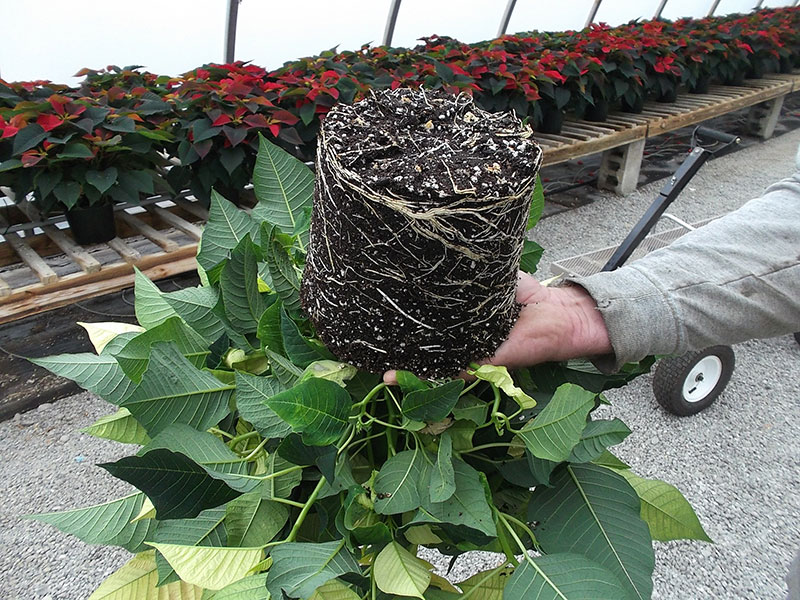
When growing poinsettias cold, check the roots to see if there is any root disease. If so, they need to be treated with a fungicide drench. Source: Premier Tech
Nutrition
All pH and nutritional issues must be corrected before beginning cool growing. When growing cool, poinsettias take up less water from the growing medium and therefore fewer nutrients. It will take more time to correct nutrient deficiencies, nutrient toxicities and pH issues using water soluble fertilizer. Test the growing medium and tissue from your poinsettia crop prior to growing cool to determine if there are problems that need to be addressed.
Growing Cool
Bract Coloring
Research by Dr. Jim Faust of Clemson University found that the early poinsettia cultivars tested will have 85% color in 5 weeks when grown cool at an average daily temperature (average of the day and night air temperatures) of 71°F (22°C), 6 weeks at 63°F (17°C) and 10 weeks at 59°F (15°C). He concluded that the average daily temperature should not be less than 60°F (15.5°C) as it takes too long to finish the crop.
Bract Size and Stem Growth
Dr. Jim Faust discovered that the average daily temperature is the most important temperature parameter that influences bract expansion. For example, if the night temperature is 55°F (13°C) and day temperature is 85°F (29°C), the average of 70°F (21°C) will have the same bract development rate as a 65°F (18°C) night, 75°F (24°C) day temperature regime. However, a warmer day temperature causes more stem expansion, so growing a poinsettia at 85°F (29°C) day temperature will cause more stem elongation than growing at 75°F (24°C) during the day. Night temperatures had little effect on stem elongation.
Cultivar Choices
Generally, red cultivars respond best to cool temperature growing. Select red cultivars that are not compact, as they will not have enough time to finish, and that have larger bracts, as cold temperatures reduce bract size. Use early flowering cultivars and expect that they will finish mid or late season due to the slower growth.
Disease
Provide good air circulation with sufficient ventilation to reduce humidity in the plant canopy. Also, space plants so air can flow between them. With cooler night temperatures, relative humidity is higher and condensation on poinsettia leaves will be a concern. Botrytis and powdery mildew will thrive in these conditions. Root disease is also more of a concern, as expressed above, due to a slower dry-out rate of the growing medium.
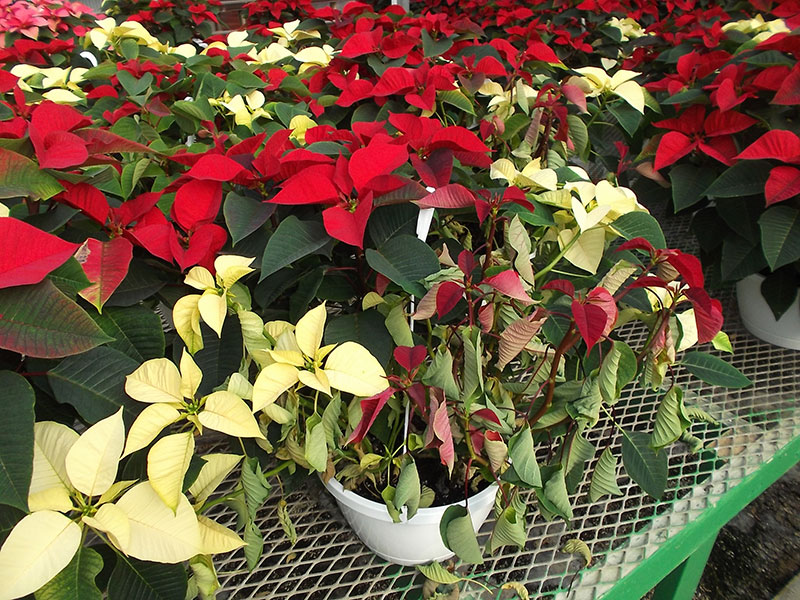
Poinsettia with root disease due to overwatering and poor spacing. This can be a concern when finishing poinsettias cold. It is important to monitor roots and allow the medium to dry out between irrigations. Source: Premier Tech
Use the Sun
On sunny days, the temperature in the greenhouse can become hot. Take advantage of the warmer days to increase the average daily temperature to push growth, bract expansion and coloring. Adjust maximum temperature set points for your automated vents and fans to higher temperatures. Humidity management may be more challenging. Keep in mind that stem stretching will also occur.
Growing cool at the end of a poinsettia crop cycle is a way to save on heating costs, but has challenges with timing as well as changes in plant growth and bract development. Doing so can be rewarding, but it is best to try this on a small portion of your crop to verify how well it works for you.
For more information, contact your Premier Tech Grower Services Representative:
 |
 |
 |
 |
|---|---|---|---|
|
Ed Bloodnick |
Nathan Wallace-Springer |
Lance Lawson |
Victor Brantly |
 |
 |
 |
|
|
Troy Buechel |
Susan Parent |
Jose Chen Lopez |
References:
- Siemonsma, Rebecca. 2008. Growing Poinsettias Cold. Grower Talks August 2008, page 36.
- Reinders, Uko. 2008. Cultivating Poinsettias at Low Temperatures. FlowerTECH 11(8):22-24.
- Vollmer, Gary. 2015. Strategies for Growing Selecta Poinsettias. Presentation at Southeast Pennsylvania Poinsettia Trial.
PRO-MIX® is a registered trademark of PREMIER HORTICULTURE Ltd.
Related Articles
-
Growing poinsettias can be a challenge considering they are sensitive to the environment, diseases, insects and watering.
-
PRO-MIX growing media for Poinsettias
Growers are getting ready for the upcoming poinsettia season and will soon be planting their crops.

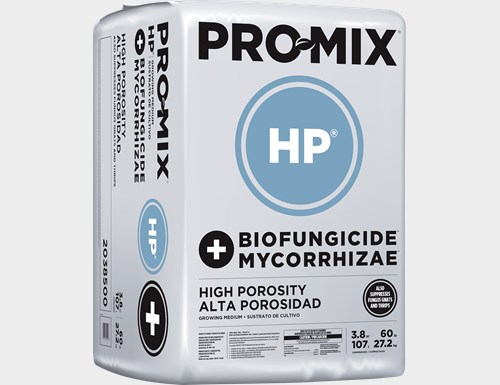
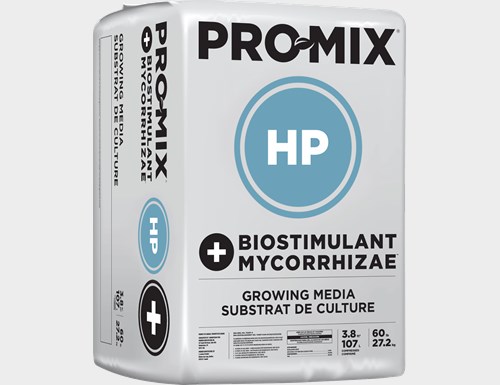
 Where to find our products
Where to find our products
